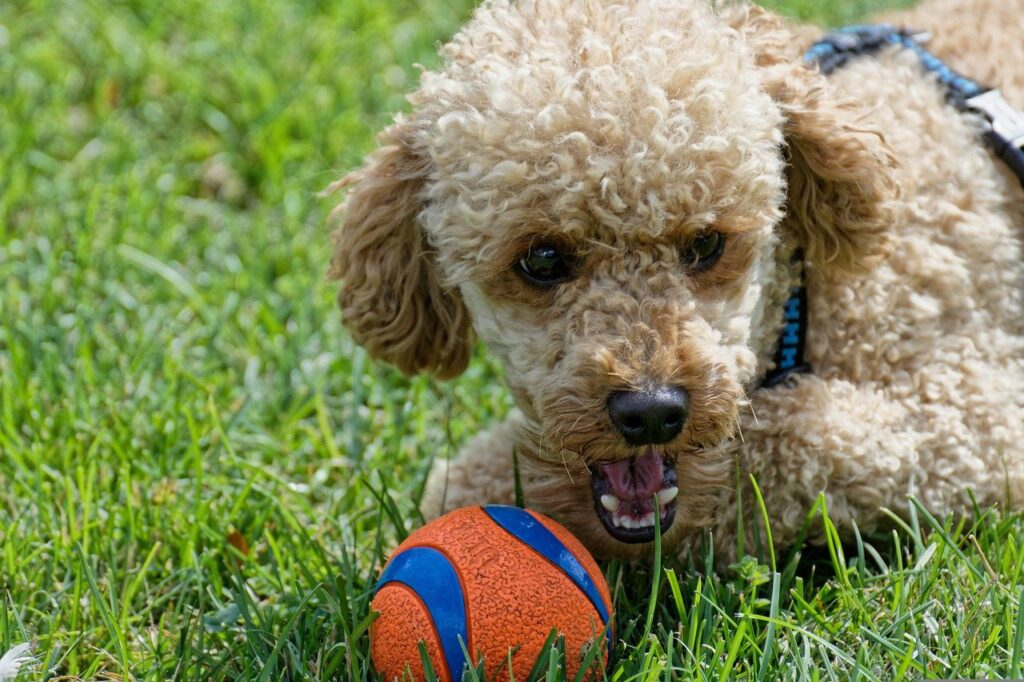As they age, dogs can develop all kinds of problems that inhibit their normal activities. With German Shepherds, these problems often occur on their hind legs. So you need to know how to make German Shepherd back legs stronger.
To strengthen a German Shepherd’s back legs, focus on exercises like controlled walks, swimming, and obstacle courses. These activities can improve their muscle tone and overall mobility. But there are a few more things you can try.
- Why are strong back legs important for German Shepherds?
- What are the common causes of hind leg weakness in German Shepherds?
- How can you recognize signs of weak hind legs?
- How do you get your dog’s hind legs to become stronger?
Why are strong back legs important for German Shepherds?
The back legs of GSD’s are made out of three main muscles that allow the dog to move as it wishes. For one, it can stand up and keep its weight. Then, it can walk, run, and jump. These functions then allow the dog to play, exercise, and keep itself active.
Weak back legs can severely hamper your German Shepherd’s leg health and ability to move comfortably. It can lead to pain, discomfort, and a decreased quality of life, limiting their enjoyment of activities.
What are the common causes of hind leg weakness in German Shepherds?
One reason for this situation is the fact that these dogs are anatomically predisposed to develop musculoskeletal problems. German Shepherds’ anatomy, including their long spine and heavy upper body, can put extra strain on their hind legs, making them susceptible to leg problems.
These dogs have their knees closer to the ground and this puts extra strain on their hind legs. They also stand and trot differently from other dogs, enchanting the strain. Dogs can develop additional age-related leg issues with their appendages. Some of these problems are common in old Jack Russell Terriers as well.
Hip dysplasia
This is a common health issue affecting German Shepherd back leg strength. It can happen in many breeds, but especially large ones. It occurs when the ball and socket joint of the hip misalign. This makes it hard for the dog to move and can lead to it developing arthritis.
Arthritis
This is an inflammation of the joints that can be caused by hip dysplasia, although there can be other causes. Injuries and infections can be common reasons. In this situation, the cartilage in the joints is affected and starts deteriorating. As time passes by, the movement in the joints becomes worse.
Degenerative myelopathy
A genetic disease affecting the spinal cord of dogs, degenerative myelopathy can start when the dog is around 8 years old. It causes dogs to progressively lose their muscle strength and lose coordination in their movement. Unfortunately, this has no cure, and with time, it will lead to paralysis. Cornell University College of Veterinary Medicine states that:
| Often, dogs are humanely euthanized within six to twelve months after the onset of clinical signs, due to the debilitating loss of mobility caused by this disease. Without euthanasia, DM can progress for more than three years and lead to an inability to walk or even breathe normally. |
Lifestyle and inactivity
Dogs that don’t move around as much, can develop stiff joints and weak muscles. Getting injured in the joints or bones can also inhibit their movement. If the dog has diabetes, it can also develop muscle weakness due to the low supply of glucose to the muscles. In leg injuries, the dog’s paw may also start peeling.
How can you recognize signs of weak hind legs?
Keeping German Shepherd hind legs healthy means noticing the signs of weakness early. These include:
- Limping, wobbling, and falling while walking
- Difficulty standing up, or looking unbalanced while doing so
- Inability and reluctance to jump on furniture and climb stairs
- Lethargy and choosing to lie down rather than stand and walk
- Pain in the affected area with whining and barking
- Reduced muscle mass in the hind legs
- Changes in posture like a hunched back
Most of these symptoms can be found in all diseases that affect the joints. If you notice one or more of them, the best thing would be to call a vet so they can give you a diagnosis.
How do you get your dog’s hind legs to become stronger?
In order to fix the muscle tone of the legs of your dog, you can do a few things. Proper exercise, supplements, and nutrition for strong dog legs are only a few of these.
What are some strengthening exercises for German Shepherd hind legs?
Exercising is the best way to strengthen muscles and make legs stronger. All dogs require some exercise and most of it can be done by simple walks around the neighborhood or dog park.
However, additional strength training will be needed for dogs with weak legs. For one, you can take your dog swimming or hiking. Swimming is great because it doesn’t affect the joints, while hiking is beneficial due to the incline in walking.
You can also do obedience training with your dog by having it stand on its back legs while you help hold its front ones. Allow the dog to stand for a while, while gradually increasing the duration every day. Playing games like tug of war or fetch is also useful for exercising. Physical therapy for dogs is also useful.
What specific nutrients are essential for leg strength?
Besides exercises for strong German Shepherd back legs, you will also need to provide proper food for the dog so it grows strong. A well-balanced diet provides essential nutrients that support muscle development and joint function.
The basics of dog food include high amounts of protein and lower amounts of carbs. Giving food like bone broth to your dog will help provide it with glucosamine and chondroitin. These two nutrients are essential in keeping the dog’s joints healthy. Minerals like calcium and phosphorus are also important as they aid in bone health. Vitamins and omega-3 fatty acids are also essential.
Try not to overfeed or underfeed the dog. Overfeeding leads to obesity and the weight puts strain on the dog’s legs.
How can you prevent leg injuries and provide proper care?
In order to do the workouts to improve German Shepherd’s hind legs, they first need to be healthy. This means working to prevent any injury that your dog might be exposed to. To do this, always monitor your dog while you are out together. If you let it run around in your yard, make sure you have a fence that prevents it from going out on the street and into traffic.
If there are any serious health conditions affecting your dog, you can get help from your orthopedic care veterinarian. Dogs with arthritis will need to receive anti-inflammatory and pain medication to reduce the inflammation. Some dogs might need to have surgery in order to fix their movement.
What other holistic approaches should you consider trying?
Building stronger hind legs for German Shepherds is not simple and might require you to try other possible treatments. Acupuncture is a treatment done by applying fine needles to certain points of the body. This is great for dog’s inflamed joints as it is believed to reduce pain and inflammation.
Chiropractic therapy is another treatment done by aligning the body of the dog by doing specific movements. “Chiropractic is one of the few modalities in veterinary medicine where results are often immediate, and are often seen within minutes of treatment.”, says Dr. Steve Marsden. You can also get your dog to a massage therapist or try to massage it yourself.
Hydrotherapy is a treatment where water is used to strengthen the muscles without affecting the joints. Then, you can also try cold laser therapy. This is done by an experienced veterinarian. This helps by reducing inflammation and pain in the joints.
How to make German Shepherd back legs stronger? – A summary
Dogs need strong legs to move around and play. GSD’s are predisposed to a lot of musculoskeletal diseases that affect their movement. Be it arthritis or degenerative myelopathy, the hind legs of your pup might not be as strong as they should be.
When their legs are weak, dogs will tend to limp and wobble while moving around. You will often see them lying on the floor and refusing to stand up and move due to the pain and weakness in their legs.
In order to strengthen their legs, you should provide proper exercise to your dog. Give it protein-rich food and supplements that aid in joint and muscle health. Other therapies like massages and acupuncture can also help.
FAQ
At what age should you start focusing on leg strength exercises for your dog?
The dog’s growth plates don’t close up until 12-18 months of age. During this time, heavy exercise is not allowed as it can cause problems. Once the dog is of adult age, you can gradually start leg exercises.
How can you ensure that your dog’s leg workouts are safe and effective?
Your veterinarian can help you develop a proper workout plan if you ask them how to make German Shepherd back legs stronger. Make sure you warm up before every exercise and use safe equipment. Start slowly and stop if it seems to get too hard.
At what age do German Shepherds start having hip problems?
These dogs can have hip dysplasia from their youngest age. However, the symptoms might not be obvious. Usually, you will notice problems with your dog’s movement once it gets to 1-2 years of age.
More dog health resources
Here are a few other resources talking about dog health.
- Why do dog leave odorless wet spots
- Valerian root dosage for dogs
- Pink spot on dogs lip
- How fast does pumpkin work for dog diarrhea
- Why are my dogs balls black
You can find a lot more information on how to keep your dog healthy on our site Dogisa!
What To Do If Your Dog Ate A Baby Wipe: Advice And Solutions
Dogs like to chew on things and sometimes they will get their chompers on something…
Do Poodles Pick A Favorite Person? – How To Be The Favorite
Poodles are loving and intelligent dogs that will fit in perfectly with your family. And…
Do Poodles Bite? – Reasons For Biting And How To Control It
Poodles are a cute dog breed that is very popular among dog owners. People usually…
Why do Dog Leave Odorless Wet Spots? And how to treat them
It is not uncommon for dog owners to notice that their dog leave odorless wet…
Why Does My Dog Only Have Diarrhea At Night? [How To Help]
Diarrhea is not an uncommon thing and most dogs will suffer from it at least…
A Complete Guide To The Corgi Heat Cycle [+ Tips]
Going into heat is what we refer to when we talk about periods in dogs….







